Most fabrics are dried in the standard way by either using a dryer, a hair dryer, or naturally air drying by using a clothesline or hanger.
For example, you may find yourself in a situation where you have to quickly wash and dry clothes for an occasion or an important meeting. Another example would be to air dry a larger load of laundry in a smaller space.
In such situations, you will undoubtedly need some sort of laundry drying hack or ideas that are more efficient.
In this article, you will learn a few laundry drying hacks that will help to ease the drying process and reduce the drying time.
These drying hacks will not only help you dry clothes faster but also walk you through different drying techniques.
Laundry Drying Hacks
The most common way to air dry your garments naturally is by making use of a clothesline. A clothesline is simply a tied rope alongside where you hang your garments to air dry.
Another way to air dry your garments is to simply lay them flat on a clean and dry surface or on a drying rack.
Out of all the drying techniques, machine drying gives you the quickest results, but some fabrics cannot be dried by a clothes dryer.
Moreover, using a clothes dryer on most occasions can even burn your pockets by increasing energy bills.
Besides using standard drying methods after washing, there are a few useful tips and hacks that you can use to speed up the overall drying process.
Let us take a quick look at some easy drying hacks to ease and speed up the drying process.
Wrap drying
Wrap drying is simply wrapping your wet garments in a cloth or a dry towel to absorb excess water.
The towel wrapping method is commonly used by women to dry their long hair after taking a shower or washing it.

Similarly, you can also use this method to quickly dry your fabrics.
Wrap drying can be used when you do not have access to a machine or other blowing tools to dry your clothes.
This drying hack will help you reduce the drying time of your garments.
It is most useful for hand-washed garments or for someone who does not own a washer to damp-dry fabrics post-wash.
Furthermore, it is also useful for fabrics that are not suitable for spin cycles or tumble drying.
To wrap and dry the wet garments, you simply need to make use of a dry towel or a thick microfiber cloth.
After you rinse your fabrics, wrap them in a towel to absorb excess water from your washed items.
Once you wrap and cover the garment evenly, gently press from all sides to absorb excess moisture.
This method is most effective when used on fluffy fabrics or fabrics with mesh or netting.
A ceiling fan or portable fan
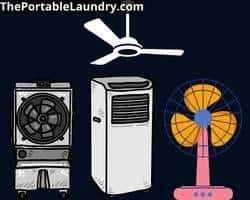
Drying your fabrics under the fan works as an alternative, especially in non-ventilated areas or in a space lacking enough airflow to dry your garments in a timely manner.
This technique is useful during the rainy season, as it is sometimes difficult to dry clothes on a clothesline in an open area.
It is not uncommon for people to put their fabrics on a drying rack and position them under the ceiling fans in their bedroom, living room, or laundry room, depending on what is most convenient for them.
Portable fans can be placed in any available space beside a drying rack to quickly dry your garments.
Hair Dryers
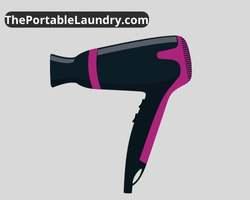
Another way to quickly dry clothes is to use a hair dryer.
Simply use a clothes hanger, clothesline, or drying rack to hang your garments and start blowing air as desired.
Alternatively, you can lay them flat on a clean and dry surface to use this method.
With normal air temperature settings, hair dryers can be used on all almost all types of garments to reduce the drying time.
For garments suitable for hot air drying, such as cotton or denim, you can just increase the temperature to slightly hot.
Note: Do not use hair dryers for a more extended period of time in single-use and let them rest at regular intervals. By doing this, you can prevent the dryer from being damaged due to overheating.
Air Blowers
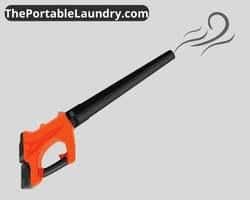
Air blowers are usually used to clean the nettings fixed over windows that prevent dust and insects.
Similar to hair dryers, you can use them to blow air over your damp garments to reduce their drying time.
Simply lay them flat or hang them while you blow air over the surface of the fabric.
Tip: When using a blower, thoroughly blow the air inside and out of your clothing openings for ideal results (for example, sleeves, neck openings, and waist openings for tops and bottoms).
Vacuum cleaner
Vacuum cleaners rely on the air suction technique to accumulate dust and debris.
They are used to clean your household flooring, including your couches, furniture, and cars.
Most vacuum cleaners blow air in reverse motion for cleaning, especially the 2-in-1 vacuum cleaners.
You can use this option to blow air over your wet and damp garments to dry them quickly.
Make sure you change the settings to blow the air out before using a vacuum cleaner.
Exhaust fans
Exhaust fans are usually used for bathrooms and kitchens, and some have them in their living rooms as well as bedrooms.
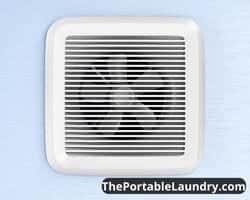
They are most commonly mounted on walls in order to offer ventilation by discharging moisture and stale smells from your household.
The installation of exhaust fans, along with a thermostat, can also optimize cooling inside the home.
Just make the necessary arrangements to hang your clothes in front of an exhaust fan by keeping a safe and ample distance for the air to move freely.
Note: Avoid using the airflow from the exhaust fans used for kitchens, especially when you are in the process of cooking. When you use oil for cooking, there are chances of fine oil particles getting discharged along with the air through the exhaust fan.
This mixture of oil and air will easily attract and settle on your garments hanging towards the fan’s outlet area.
If this happens, it may become difficult to get rid of the oily spots or you may have to rewash your garments, and in the worst case, it can cause damage to your expensive garments.
Air conditioning outlet unit or a duct
Most often we install the air conditioner’s outlet duct to the balconies or towards the closest outer walls of the house.
Some individuals even install them on the terrace, depending on the fixture and requirements.
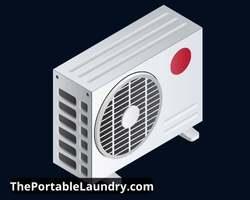
It would be ideal to set up a clothesline and hang your clothes opposite the duct if there is a suitable space.
Air conditioners usually blow hot air from the duct and they can be utilized to dry your fabrics quickly at the same time while cooling your room.
If the duct is placed on the outer floor, then you can use a drying rack to hang your garments and dry them while you run the air conditioner. You’ll be amazed at how quickly the clothes dry.
Nearly all fabric types are suitable for the mild hot air blown by the air conditioner’s duct.
Sun drying

For fabrics suitable for sun drying, simply dedicate an area to hang your fabrics in an open space.
You can choose a space outside your house, such as a garden or on your balcony, where you get access to direct sunlight.
The terrace could be one of the best places to dry your laundry in the sun.
Simply install a clothesline or place a drying rack to quickly dry your garments in the sunlight.
Note: Some fabric types may not be suitable for sun drying and can cause fading spots. Hence, refer to the care labels before you place them under direct sunlight.
Clothes Hanger

Clothes hangers are specifically designed to fold your garments evenly and store them in your wardrobes.
These hangers can be used to hang dry your clothes after washing.
Clothes hangers come in handy when you have to dry a larger load of laundry in a smaller space.
Using clothes hangers can save a lot of space on a clothesline, and they can also be placed in any corner of your house.
For instance, if you currently hang five items in a single row on your clothesline, you can increase this number to fifteen by using a clothes hanger.
Also Read: How to Install a Clothesline Tightener?
Home Furniture
If you have larger loads of laundry to dry, then you can make use of your home furniture, such as couches and chairs, to lay your fabrics for drying.
This will be helpful in cases where you lack space on a clothesline or the drying racks.
Make sure you do not lay your wet garments over the furniture with leather covers or wood that cannot resist wet or damp environments.
Similarly, never place any wet garment over an electronic appliance for drying purposes.
Final Thoughts
Drying hacks are quite useful to help dry fabrics quickly, but you should always make sure to use each option only if it is suitable for your fabric type.
For items not suitable for wringing, you should always shake off excess water after every wash before drying.
Do not use any type of handy blowers with excess heat setting or for a longer time in single-use and it is best to avoid sun-drying for certain fabrics that are likely to fade in sunlight when they are wet or damp.
Lastly, read the care label before deciding to dry your fabrics by using any of the above-mentioned methods.
You May Also Like
- Five Stages Of Laundry Process (Explained)
- What is a FoldiMate in Laundry? (Benefits & Drawbacks)
- What is a Laundry Marker? (Explained)
- Difference Between Laundry Sink And Utility Sink (Explained)
- Laundromats OR Home Laundry? (Which is Cheaper?)
- Which is Better Laundry or Dry Cleaning? (Explained)
- What is a portable laundry hamper? (Explained)
- Laundry Bags: 11 Commonly Asked Questions Answered
- Can you use baking soda as laundry detergent?
- Laundry Pods: 12 Answers you should know
- High Efficiency Laundry detergents: 11 Things Everyone should know
- Should You Wash Spot Clean Only Fabrics Or Clothes? (Explained)
- How To Wash Bed Net In Washing Machine? (Easy Way)

